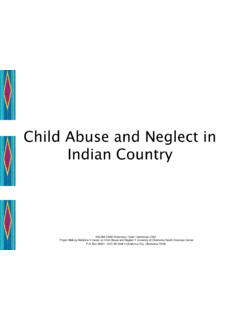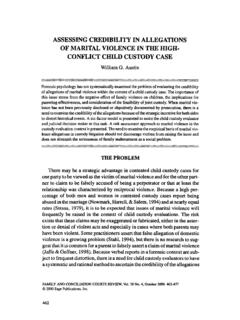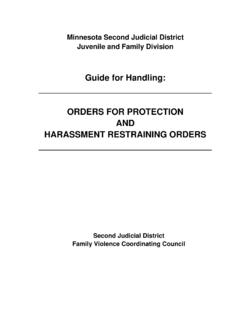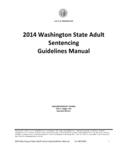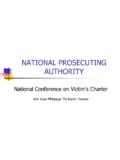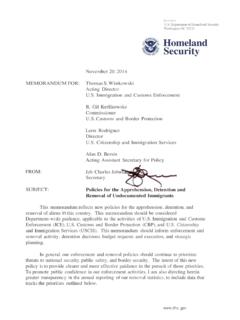Transcription of MULTIDISCIPLINARY TEAMS AND CHILD PROTECTION …
1 IHS/BIA CHILD PROTECTION Handbook - 2005 MULTIDISCIPLINARY TEAMS and CHILD PROTECTION TEAMS By: Eidell Wasserman, PhD Definition: Both MDTs and CPTs are a team with representatives from a variety of community agencies which meet to discuss issues dealing with CHILD abuse and neglect cases. The purpose of each type of team is different but the PROTECTION of the children in the community is the common goal. What is a MULTIDISCIPLINARY team ? A MULTIDISCIPLINARY team (MDT) is a team with representatives from a variety of disciplines (agencies) which meet to discuss CHILD abuse and neglect cases. The people represented on the team may vary from community to community resulting in many different forms of a MDT. Perhaps the most common question regarding MDTs is, "How is a MDT different from a CHILD PROTECTION team (CPT)?" There can be a variety of definitions of CPTs and MDTs. Typically, a MDT is defined as a prosecution based team , focusing on CHILD abuse and neglect cases involved in the legal/judicial system, while a CPT focuses on CHILD PROTECTION .
2 A CPT has the responsibility to insure that children who are victims of abuse or neglect are protected from additional maltreatment. CHILD PROTECTION often involves civil action while prosecution is a criminal justice issue. While CPTs and MDTs may share members from the same agencies, there are important differences. Both CPTs and MDTs have the common goal of developing a coordinated system to respond to CHILD abuse and neglect cases. MDT/CPT Focus Common Goal Developing a coordinated system to respond to abuse and neglect cases. MDT CPT Focus prosecution Focus Focus PROTECTION Focus Action Criminal action Action Civil action Project Making Medicine Center on CHILD Abuse and Neglect University of Oklahoma Health Sciences Center Box 26901- CHO 3B 3406 Oklahoma City, Oklahoma 73190 << 1 >> IHS/BIA CHILD PROTECTION Handbook - 2005 Benefits of MDT/CPTs Development of experience and expertise in case management Consultant training Liaison and linkage building Community-program development An understanding of ones own role and that of other professional roles and expertise Open communication Written protocols, formalized working agreements, policies, and procedures One of biggest difficulties in CHILD abuse cases is effective criminal prosecution .
3 Only a small percentage of reported cases of CHILD maltreatment are ever criminally prosecuted. The difficulties in successfully prosecuting CHILD abuse cases are well known. These difficulties include lack of witnesses, victim unwillingness to testify and/or retracting their disclosure of the abuse, lack of physical evidence, prosecutorial discomfort with trying CHILD abuse cases, etc. It is often the criminal justice system that is considered a "weak link" because of the limited number of cases that actually go to court. As communities become aware of the effect of CHILD abuse and neglect, the communities may be disappointed in the limited number of cases that are criminally prosecuted. In response to issues of CHILD abuse and neglect, communities may develop MDTs to make sure that all cases receive adequate prosecutorial review (or attention by the prosecutors office whether tribal, federal or state). To insure that such review takes place, it is vital that the appropriate prosecutor(s) be consistent participants at the MDT meetings.
4 Establishment of a MULTIDISCIPLINARY Approach Establishment of the importance of a MULTIDISCIPLINARY approach can be seen in federal legislation mandating the establishment of MDTs. Public Law 101-630, the Indian CHILD PROTECTION and Family Violence Prevention Act is one such piece of legislation. Section 3209(e) states that "each MULTIDISCIPLINARY team established under this section shall include, but is not limited to, personnel with a background in 1) law enforcement, 2) CHILD protective services, 3) juvenile counseling and adolescent mental health, and 4) domestic violence." The 1995 Attorney General Guidelines for Victim and Witness Assistance also recognizes the importance of MDTs and includes these guidelines; consultation with MULTIDISCIPLINARY (g) ..provides that the court and the attorney for the government shall work with established MULTIDISCIPLINARY CHILD abuse TEAMS designed to assist CHILD victims and CHILD witnesses, and shall consult with such Project Making Medicine Center on CHILD Abuse and Neglect University of Oklahoma Health Sciences Center Box 26901- CHO 3B 3406 Oklahoma City, Oklahoma 73190 << 2 >> IHS/BIA CHILD PROTECTION Handbook - 2005 MULTIDISCIPLINARY CHILD abuse TEAMS as appropriate.
5 Membership MDT is defined as a prosecution -based team which deals with CHILD abuse and/or neglect cases. The composition and role of MDTs can vary from community to community. Many MDTs focus only on cases of sexual abuse and severe physical abuse since these are the cases that are most likely to result in criminal prosecutions. A prosecution -based team must have prosecutors as key members. Other key members include: law enforcement, social services, medical, mental health personnel, and victim advocate. The Attorney General's Guidelines (1995) suggest that members of the MDT include: medical, psychological, and psychiatric personnel. Information pertaining to criminal proceedings can only be discussed on a "need to know basis" so MDT membership must be limited. As with a CPT, additional or secondary professionals can be invited to discuss specific cases when necessary.
6 Educators, public health workers, juvenile corrections personnel, domestic violence program staff, guardian ad litems, family support and CHILD care agency workers, and court-appointed special advocates may also be core or secondary team members. In Indian Country, it is critical that both the tribal and federal prosecutors attend the MDT meetings. In some federal jurisdictions, a specific Assistant Attorney is assigned to one or more tribal MDTs. The presence of the prosecutor allows for timely discussion of case progress and a determination of which jurisdiction is the best venue for criminal prosecution of a case. It is vital to have the prosecutor present at every meeting. In some instances, the or District Attorney may send a Victim Advocate or Victim Witness Coordinator to represent their office at the MDT meeting. A victim services provider is a vital component of a MDT but a Victim Witness Coordinator does not have the knowledge about criminal prosecution that an Assistant Attorney has.
7 In most Indian communities both the tribe and the federal government have overlapping jurisdiction over cases of sexual abuse, severe physical abuse, and some types of neglect cases. In cases governed by Public Law 280, the tribe and the state may have overlapping or parallel jurisdiction. When there is concurrent jurisdiction, it is important that the criminal investigations and prosecutorial decisions be coordinated. Project Making Medicine Center on CHILD Abuse and Neglect University of Oklahoma Health Sciences Center Box 26901- CHO 3B 3406 Oklahoma City, Oklahoma 73190 << 3 >> IHS/BIA CHILD PROTECTION Handbook - 2005 Training for MDT/CPT members It is also important that the professionals on the MDT are highly trained in the dynamics of CHILD abuse and neglect. Physicians who participate on the team are often those who actually perform CHILD abuse examinations. A well-trained physician will be able to educate their peers on the MDT regarding the types of medical procedures which can be utilized in a CHILD abuse examination and what types of information these procedures can yield.
8 Members of the MDT should be encouraged to attend trainings together. Cross discipline training is vital. Such cross training allows everyone to operate from a common set of principles or a similar understanding. Usually law enforcement personnel go to law enforcement trainings where they learn about issues such as evidence gathering, chain of custody, interviewing suspects, etc., which is different for mental health workers who go to conferences focusing on the treatment of sexually abused children and adolescents, psychological assessment, and post traumatic stress disorder. Therefore, it is important for professionals from differing backgrounds and training to understand and respect each other's work and professional abilities. Cross training assists in building competent and effective TEAMS . What does a MDT/CPT do? The prosecution -based team insures that appropriate criminal justice attention is paid to each case. In the past, cases have sometimes "fallen through the cracks" and no criminal prosecution has been pursued.
9 For example, a CHILD sexual abuse case is reported to Social Services and the CHILD is removed from the home and placed with relatives. The CHILD PROTECTION Worker manages the case to make certain that the CHILD receives all necessary services, including therapy. The parents enter into an informal agreement with Social Services to attend parenting classes and individual therapy. There still remains the issue of criminal prosecution . What about the alleged offender? Who makes sure that the offender does not have access to the victim? Will there be a criminal prosecution of the offender in tribal and/or federal court? These are the types of issues that are addressed in a MDT meeting. At a MDT meeting, typically the first order of business is to review all the cases of reported abuse and insure that these cases have been reported to law enforcement. Next is an assessment of the law enforcement status. Where is the case in terms of the criminal investigation?
10 This is law enforcement's opportunity to discuss the status of their case and to identify any assistance other team members can provide to facilitate their investigation. Such discussions highlight another purpose of the MDT: tracking cases from a criminal justice perspective. The MDT meeting offers the opportunity for professionals to work together. A tribal Criminal Investigator (CI), for example, can update the other members on the status of their investigation of particular cases. If there is not enough evidence the CI may discuss the Project Making Medicine Center on CHILD Abuse and Neglect University of Oklahoma Health Sciences Center Box 26901- CHO 3B 3406 Oklahoma City, Oklahoma 73190 << 4 >> IHS/BIA CHILD PROTECTION Handbook - 2005 case in the MDT meeting and may request additional information from the MDT which may help in the investigation. Perhaps there is certain medical evidence that the Indian Health Service pediatrician could provide, or maybe a letter from the victim's teacher regarding the CHILD 's behavior in the presence of the alleged perpetrator would be helpful.



